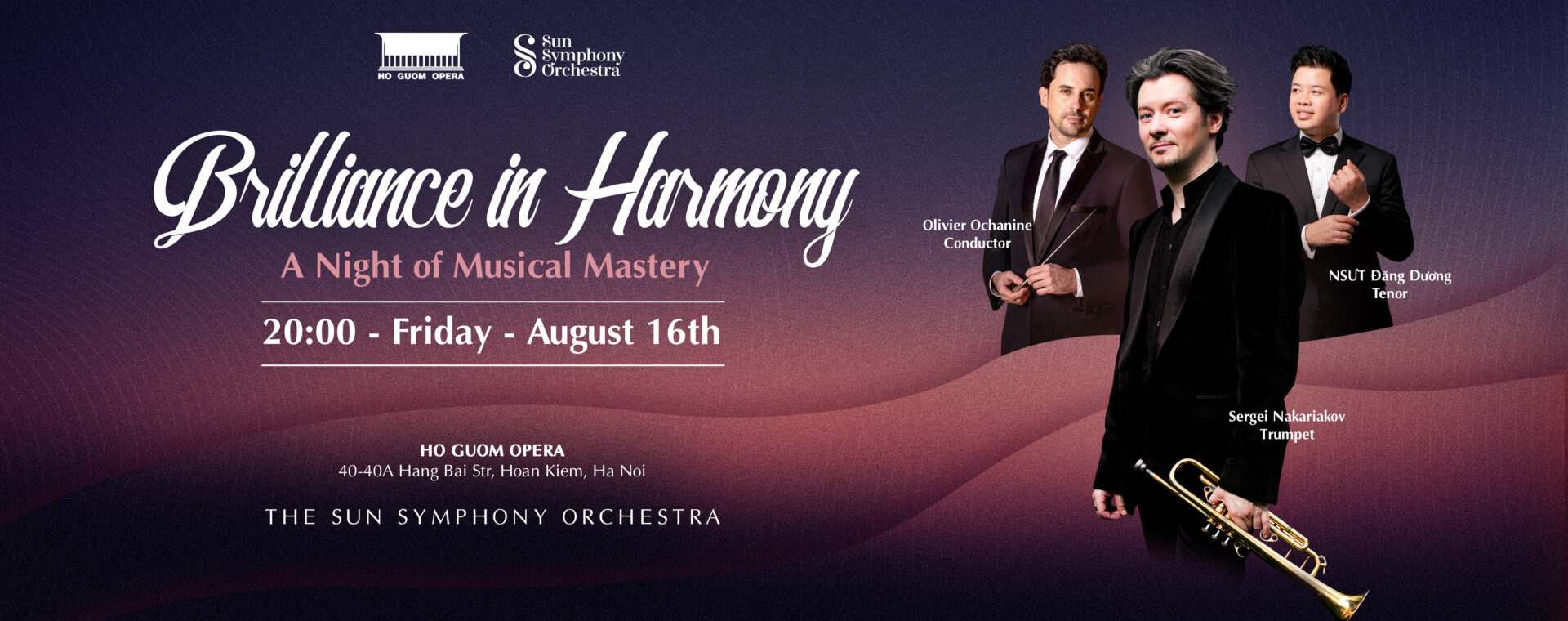Short description
It's not every day that a world-renowned trumpeter the likes of Sergei Nakariakov comes to Hanoi! Here comes a very special collaboration of Nakariakov with Olivier Ochanine and the Sun Symphony Orchestra that will take place on August 16! Hummel's Trumpet Concerto in Eb Major will be performed, as well as the stirring Orchestra Suite No. 3 of Tchaikovsky, never before performed in Vietnam!
VĂN CAO
Đàn chim Việt
NSƯT Đăng Dương, Tenor
NGUYỄN ĐÌNH THI
Người Hà Nội
NSƯT Đăng Dương, Tenor
MOZART
Overture to The Marriage of Figaro
HUMMEL
Trumpet Concerto in E Major. S. 49
Sergei Nakariakov, Trumpet
TCHAIKOVSKY
Suite No. 3 for Orchestra in G, Op. 55
“Brilliance in Harmony: A Night of Musical Mastery” concert
20h00, August 16, 2024, Ho Guom Opera House
📞 Ticketing: 300.000vnd | 500.000vnd | 1.000.000vnd | 2.000.000vnd
📱 Free delivery in Hanoi: 0965 765 946 (Vietnamese speaking) – 0913 489 858 (English speaking)
Seating plan & ticket booking: https://forms.gle/S3GVzuQV556w5RgX8
The programme tonight begins with two well loved Vietnamese songs honoring Vietnam and the upcoming National Day, with none other than popular singer Đăng Dương. The first song, Nguoi Hanoi, brings the listener a beautiful melody that celebrates the city of Hanoi and the feeling of victory. The second song, composed by Van Cao, evokes the images and metaphors surrounding the various moods of wartime soldiers and is often sung to celebrate the national unity of Vietnam.
Mozart and Tchaikovsky fit together on any programme like bread and butter. While notably different in style, composition period and many other elements, Tchaikovsky was enormously idolized Mozart, and the latter’s influence is markedly apparent in much of the music Tchaikovsky composed. Aside from the 4th Orchestral Suite – entitled “Mozartiana” -, much of Tchaikovsky’s music, including the String Serenade, pays clear homage to Mozart.
Mozart – Overture to the Marriage of Figaro
We start with the energetic and lighthearted Overture to the Marriage of Figaro, Mozart’s musical rendition of a play that took Europe by storm in the 1780s with its wittiness and comedic story. The overture, as was usually the case during this era, does not foretell melodic or thematic elements from the opera, but is instead a standalone work that has pleased audiences for more than two centuries. It starts with an excited murmur in the low strings and bassoons, as if a gossip is in session; it abruptly erupts into a sparkling and vivacious allegro. The mood for the opera has been set. This overture, incidentally, was completed just two days before the opera’s premiere.
Hummel – Trumpet Concerto in E Major. S. 49
Tonight’s soloist, the world-renowned Sergei Nakariakov, comes to Hanoi to present the virtuosic Trumpet Concerto in Eb Major by Hungarian-born Johann Nepomuk Hummel. Hummel was a student of Mozart’s, and like Mozart was a child prodigy. Composed in the standard classical sonata form, with 2 stylistic characters in the opening movement, a lilting & dramatic second movement, and a lighthearted & playful closing movement, this concerto has all of the hallmarks of Viennese Classicism. The virtuosic nature of this piece shows off the technical, lyrical, and chromatic capabilities of both the modern trumpet and its predecessor. Originally written in E Natural, the piece was transposed to accommodate the technical elements of the modern valve trumpet.
Tchaikovsky – Suite No. 3 for Orchestra in G, Op. 55
The main item on the menu for tonight’s concert is the Tchaikovsky Orchestral Suite No. 3, written in 1884, stems from a period in Tchaikovsky’s life that had seen him dissolve his disastrous marriage, followed by his success from his recent opera Mazeppa as well as having been presented by Czar Nicholas Alexander III with Russia’s highest civilian decoration, the Order of St. Vladimir. This all seemed to herald a new chapter for the composer; he had also begun his letter correspondence with his benefactress, Nadezhda von Meck, and his fame was growing in leaps and bounds.
Tchaikovsky chose to spend a period of rest at Kamenka, the country estate of his sister Sasha and her husband, Lev Davidoff, where he took up the study of Mozart’s Magic Flute opera, attempted learning English, and spent much time wandering in the surrounding woods. The 3rd Suite, which he wrote during this period, became his most widely performed orchestral work for quite some time (nowadays of course his symphonies have become much more popular). The success of this beautiful suite also provided Tchaikovsky with his first American triumph when he conducted it with the New York Symphony Society on May 7, 1891 – in Carnegie Hall, a few days after the hall’s dedication.
Originally a five-movement suite (the movement “Contrastes” was removed and became a standalone work for piano and orchestra), the suite opens with a gorgeous elegy, with a string serenade of lush and tender melodies. All the movements of this suite are highly ballet-like; naturally, we all know Tchaikovsky as the composer of three endlessly popular ballets. The second movement is dark, a ‘melancholic waltz’ which highlights Tchaikovsky’s genius of orchestration and of the use of color. The third movement is a tarantella that pushes the extremes of ensemble unity with its constant, interrupting exchanges between winds and string. The finale is a large-scale theme and variations that culminates in a brilliant polacca (polonaise)! This movement shows off Tchaikovsky in his fully mature compositional period, each successive variation as unique as the other. Tchaikovsky frequently conducted this final movement as in independent work, and it has been used for a production choreographed by George Balanchine in 1947, bringing the material of the finale into a medium in which it beautifully belongs – the ballet.
